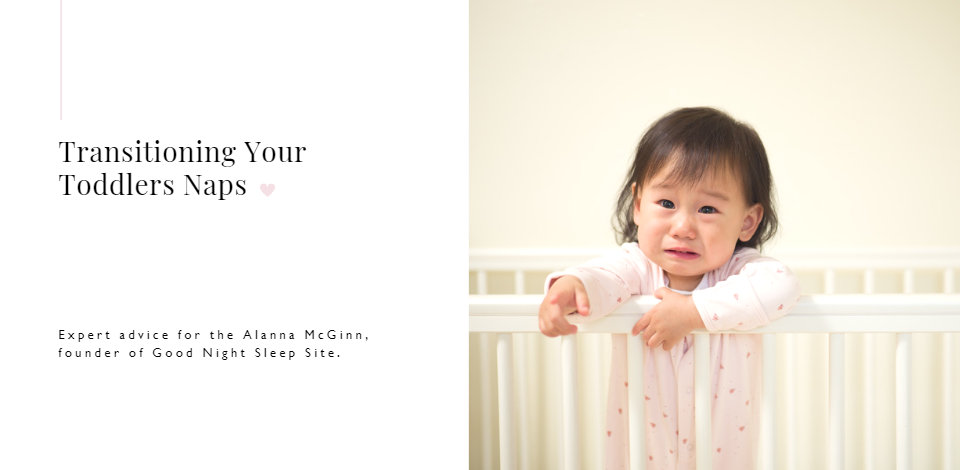Transitioning your Toddler's Naps
Jump to Section

One of the most common questions parents of toddlers ask me is when their toddler should be transitioned to one nap and how to do it effectively. I firmly believe that naps are one of the fundamentals of healthy sleep and that well rested children are far more likely to sleep through the night than overtired ones.
Sleep begets sleep – so that a child who gets enough rest during the day will sleep better at night than one who doesn’t. Toddlers taking two daily naps should still be getting between 1 and 1.5 hours of sleep at each nap. When removing one of the naps, it is important to remember that we aren’t removing the need for sleep – we are simply redistributing that sleep to bedtime and the other nap period. When the morning nap is removed, the afternoon nap usually increases to between 1 and 3 hours. Additionally, you may find that bedtime needs to be moved earlier for a period until your toddler adjusts to the new sleep schedule.
Once your preschooler (3-4 years old) outgrows the need for daily naps, I strongly recommend keeping some quiet time in the former nap time slot to help them recharge (and give you a break too).
One of the biggest mistakes parents make regarding naps is removing them too soon. Before transitioning your child to one nap, watch them for a week or two and see if they consistently show these.
Signs of being ready to transition to a single nap
- Morning nap is pushed too far and disrupts afternoon nap – making it too late to be helpful.
- Your child is consistently skipping the afternoon nap.
If your child is under 15 months of age, I strongly recommend waiting until they reach that age before making any adjustments as young toddlers often go through sleep regressions that can wreak havoc on nap times. Once they grow out of this phase, the child often goes back to sleeping on the same schedule they did before the regression. If the child is still going to bed early (anytime between 6 and 7 pm) with two naps, then they should stay on the two nap schedule. If your child is sleep sensitive, they may need to hold onto two naps for longer – even until they’re 18 months of age. You don’t want to rock the sleep boat unnecessarily. Even though a child may not need as much sleep from a developmental point of view, transitioning to one nap can cause sleep issues to creep up, especially if it is done too early. I advise parents to keep two naps for as long as possible as long as it is not disrupting bedtime or pushing it too late.
How to Transition From 2 Naps to 1
Once you have decided your child is ready to switch to one nap there are a couple of ways to do it:
Method 1 - Cold turkey
If you feel that your child will be able to handle the switch and move to a single afternoon nap at an earlier time (like 12:00 pm), then go for it. Remember that we want to redistribute the missing sleep time from the morning nap, so gradually try to lengthen the time your child naps until the missing sleep is accommodated. If your child was sleeping for an hour in the morning and an hour in the afternoon, your goal will be to make the afternoon nap period 2 hours.
Method 2 - Rescheduling Morning Naps
If you’re not sure that the cold turkey method will work for your child, then try pushing the morning nap later by 15 minutes every day until you are at a 12:00 or 12:30pm single naptime.
By age 3 or 4, most children can successfully end all napping. The transition to no naps can be hard on everyone – parents and kids alike, and I recommend maintaining an hour or more of quiet time into the afternoon and keeping it until the child enters full day schooling. Not only will it help your child recharge, it’s a great break for the caregiver as well.
I always suggest having some special quiet time toys that only come out during that period. Go to the dollar store or thrift shop and pick out a few books, puzzles, or toys without sound and put them in a box labelled “Quiet Time”. When it’s time for quiet time, have your child pick one of the special toys to play with in his room. He may even fall asleep! After quiet time, your child can put the toy back in the box to be played with again at the next quiet time.
The transition to one nap and then to no naps can be hard on both parents and children, but by making sure your child is ready and adjusting their sleep so that they aren’t losing sleep, you can make the transition easier on everyone.
Good Night, Sleep Tight
Transitioning your toddler's naps can be challenging, but it's crucial for their sleep health. Watch for signs of readiness, avoid removing naps too soon, and consider quiet time for older children. Choose between the cold turkey or gradual method when transitioning to one nap. Maintain quiet time as your child outgrows naps. With patience and adjustments, the transition can be smoother for everyone involved.

